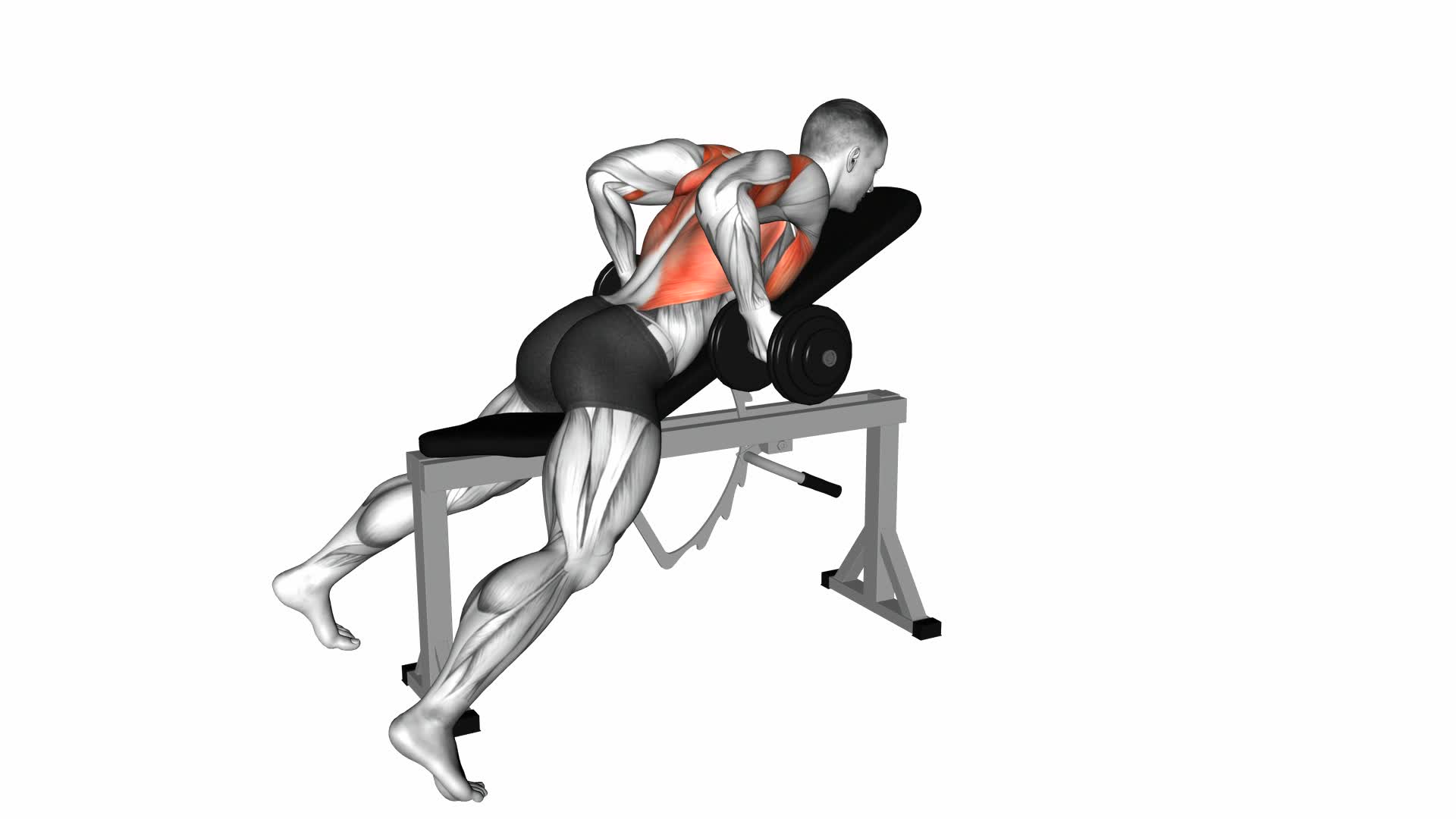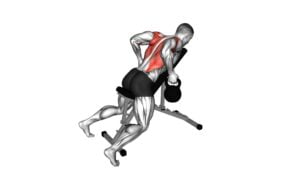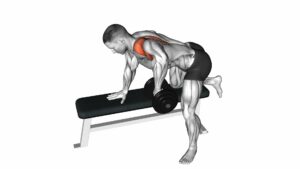Dumbbell Lying Rear Delt Row – Video Exercise Guide & Tips

Looking to strengthen your rear deltoids? The Dumbbell Lying Rear Delt Row is the perfect exercise for you.
Watch This Exercise Video
In this video exercise guide, we'll show you the proper form and technique, as well as provide tips to maximize your rear delt workout.
Don't worry about making mistakes – we'll also cover common ones to avoid.
So grab your dumbbells and get ready to sculpt those shoulders!
Key Takeaways
- Strengthens and tones rear deltoid muscles
- Targets muscles at the back of the shoulders
- Improves posture and upper body strength
- Corrects muscle imbalances
Benefits of the Dumbbell Lying Rear Delt Row
By performing the Dumbbell Lying Rear Delt Row, you can effectively strengthen and tone your rear deltoid muscles. This exercise specifically targets the rear deltoids, which are the muscles located at the back of your shoulders. Strengthening these muscles can improve your posture and enhance your overall upper body strength.
One of the key benefits of the Dumbbell Lying Rear Delt Row is that it helps to correct muscle imbalances. Many people tend to have stronger front deltoids compared to their rear deltoids, which can lead to rounded shoulders and poor posture. By incorporating this exercise into your workout routine, you can work towards achieving a more balanced shoulder musculature.
Another benefit of this exercise is that it can help to improve your shoulder stability. The Dumbbell Lying Rear Delt Row requires you to engage your core muscles as you stabilize your body on the bench. This not only strengthens your rear deltoids but also works your entire shoulder girdle.
To reap the full benefits of this exercise, it's important to maintain proper form. Start by lying face down on an incline bench, holding a dumbbell in each hand. With your palms facing each other, lift the dumbbells out to the sides, squeezing your shoulder blades together at the top of the movement. Keep your elbows slightly bent and avoid using momentum to lift the weights. Focus on engaging your rear deltoids throughout the exercise.
Incorporating the Dumbbell Lying Rear Delt Row into your workout routine can provide numerous benefits, including improved posture, increased shoulder stability, and enhanced upper body strength. Remember to always prioritize proper form to maximize the effectiveness of this exercise.
Proper Form and Technique for the Exercise
To perform the Dumbbell Lying Rear Delt Row with proper form and technique, there are three key points to focus on:
- Shoulder stability and alignment: Maintaining proper shoulder stability and alignment throughout the exercise is crucial to prevent injury and maximize effectiveness.
- Grip and hand placement: The grip and hand placement should be comfortable and secure, allowing for a controlled movement.
- Breathing and core engagement: Lastly, breathing properly and engaging your core will help maintain stability and control throughout the exercise.
Shoulder Stability and Alignment
To ensure proper form and technique for the Dumbbell Lying Rear Delt Row exercise, you should focus on maintaining shoulder stability and alignment. Shoulder stability is crucial to prevent injury and maximize the effectiveness of the exercise.
Here are three key tips to help you achieve proper shoulder stability and alignment:
- Keep your shoulders down and back: Engage your shoulder blades by pulling them down and back towards your spine. This helps activate the muscles in your upper back and promotes better posture.
- Maintain a neutral spine: Keep your back flat against the bench and avoid arching or rounding your back. A neutral spine position will help distribute the load evenly and reduce the risk of strain on your shoulders.
- Control the movement: Slowly lower the dumbbells down to the starting position, focusing on maintaining control throughout the exercise. Avoid using momentum or swinging your arms, as this can compromise shoulder stability.
Grip and Hand Placement
Maintain a firm grip on the dumbbells and position your hands in a neutral position for proper form and technique during the Dumbbell Lying Rear Delt Row exercise. Having a strong grip is essential for this exercise as it helps you control the dumbbells and prevents them from slipping out of your hands. To improve grip strength, you can incorporate exercises like farmer's walks or using grip strengtheners.
When positioning your hands, make sure they're in a neutral position, neither pronated nor supinated. This helps in preventing wrist strain and allows for better engagement of the targeted muscles. By maintaining a proper grip and hand placement, you can perform the Dumbbell Lying Rear Delt Row exercise effectively and minimize the risk of injuries.
Now let's move on to the next section about breathing and core engagement.
Breathing and Core Engagement
During the Dumbbell Lying Rear Delt Row exercise, focus on engaging your core and maintaining proper breathing. These two aspects are crucial for maximizing the effectiveness of the exercise and preventing injury. Here are some key points to remember:
- Breathing techniques: Inhale as you lower the dumbbells towards your chest and exhale as you lift them back up. This rhythmic breathing pattern helps you maintain control and stability throughout the movement.
- Engaging the core: Before you begin the exercise, consciously activate your core muscles by pulling your belly button in towards your spine. This helps stabilize your body and protects your lower back.
- Maintain proper form: Throughout the exercise, keep your back flat against the bench and avoid arching it. Focus on squeezing your shoulder blades together as you lift the dumbbells, targeting the rear deltoid muscles effectively.
Choosing the Right Dumbbell Weight
When choosing the right dumbbell weight for the dumbbell lying rear delt row exercise, it's important to find the ideal weight that challenges you without causing unnecessary strain or compromising your form.
Selecting a weight that's too heavy can lead to improper technique and increase the risk of injury, while choosing a weight that's too light may not provide enough resistance to effectively target the rear deltoids.
It's recommended to start with a moderate weight and gradually increase as you become stronger and more comfortable with the exercise.
Finding Ideal Weight
To determine the ideal weight for your dumbbell lying rear delt row, start by selecting a suitable starting weight based on your current strength and fitness level. This will help you effectively target and engage your rear delts without compromising form or risking injury.
Here are three key factors to consider when choosing the right dumbbell weight:
- Start with a weight that allows you to perform the exercise with proper form and technique. This means maintaining a neutral spine, keeping your shoulder blades retracted, and feeling the tension in your rear delts throughout the movement.
- Gradually increase the weight as you become more comfortable and confident with the exercise. Aim for a weight that challenges you without causing excessive strain or compromising your range of motion.
- Listen to your body and adjust the weight accordingly. If you find that you're not feeling the exercise in your rear delts, the weight may be too light. Conversely, if you're struggling to maintain proper form, the weight may be too heavy.
Avoiding Unnecessary Strain
To avoid unnecessary strain and ensure efficient results, choose the right dumbbell weight for your dumbbell lying rear delt row based on factors such as maintaining proper form and feeling the tension in your rear delts throughout the movement. By selecting the appropriate weight, you can prevent injury and prevent muscle imbalances.
Using a weight that's too heavy can put excessive strain on your muscles and joints, increasing the risk of injury. On the other hand, using a weight that's too light may not provide enough resistance to effectively challenge your rear delts and stimulate muscle growth.
It's important to find a weight that allows you to perform the exercise with proper technique and control, while still feeling a moderate level of tension in your rear delts. This will ensure that you're targeting the intended muscles and maximizing the benefits of the exercise.
Variations and Alternatives to the Exercise
You can often modify or substitute the Dumbbell Lying Rear Delt Row exercise to target different muscle groups. Here are some variations and alternatives that you can try:
- Standing Rear Delt Row: Instead of lying face down on a bench, stand up and bend forward at the waist. Hold a dumbbell in each hand and row them up towards your chest, squeezing your shoulder blades together. This variation engages your rear deltoids and upper back muscles in a slightly different way.
- Seated Cable Rear Delt Row: Sit on a cable row machine with your feet on the footrests and your knees slightly bent. Grasp the handles with an overhand grip and pull them towards your chest, squeezing your shoulder blades together. This modification allows for a more controlled movement and provides constant tension on the rear delts.
- Resistance Band Rear Delt Row: Loop a resistance band around a stationary object at chest height. Hold the band handles with your palms facing each other and step back to create tension. Pull the bands towards your chest, keeping your elbows close to your body. This alternative is great for those who don't have access to dumbbells or cable machines.
Now that you know some variations and alternatives to the Dumbbell Lying Rear Delt Row, let's move on to the next section about common mistakes to avoid.
Common Mistakes to Avoid
Avoiding these common mistakes will help you get the most out of the Dumbbell Lying Rear Delt Row exercise. One of the most important things to remember is to maintain proper form throughout the exercise. This won't only ensure that you're targeting the right muscles, but it will also help you avoid injury.
A common misconception is that using heavier weights will give you better results. However, using weights that are too heavy can put unnecessary strain on your shoulders and increase the risk of injury. It's important to choose a weight that allows you to perform the exercise with proper form and without any pain or discomfort.
Another mistake to avoid is using momentum to lift the weights. This takes away the emphasis from your rear delts and can lead to ineffective results. Instead, focus on using controlled movements and squeezing your shoulder blades together at the top of the movement.
By avoiding these common mistakes, you can ensure that you're getting the most out of your Dumbbell Lying Rear Delt Row exercise and minimizing the risk of injury.
Transitioning into the subsequent section about 'tips for maximizing your rear delt workout', it's important to remember that proper form and technique are key to achieving optimal results.
Tips for Maximizing Your Rear Delt Workout
Are you wondering how you can maximize your rear delt workout and achieve optimal results? Maximizing rear deltoid growth requires effective rear delt exercises. Here are three tips to help you get the most out of your rear delt workout:
- Focus on proper form: To target your rear delts effectively, it's crucial to maintain proper form throughout the exercises. Keep your shoulders back and down, and avoid using momentum to lift the weights. This will ensure that your rear delts are doing the work, leading to better results.
- Use a variety of exercises: Incorporating a variety of exercises into your routine can help target different areas of your rear delts and prevent plateauing. Try exercises like dumbbell lying rear delt rows, face pulls, and bent-over lateral raises to work your rear delts from different angles.
- Progressive overload: To maximize rear deltoid growth, it's important to progressively overload the muscles. Gradually increase the weight or the number of repetitions you perform over time. This will challenge your rear delts and stimulate muscle growth.
Frequently Asked Questions
Can I Perform the Dumbbell Lying Rear Delt Row Without a Bench?
Yes, you can perform the dumbbell lying rear delt row without a bench. However, using a bench offers several benefits such as providing stability and support for your upper body during the exercise.
It also allows for a greater range of motion, targeting the rear deltoids more effectively.
If you don't have a bench, you can try alternative exercises like standing rear delt rows or bent-over dumbbell rows to work your rear delts.
How Often Should I Incorporate the Dumbbell Lying Rear Delt Row Into My Workout Routine?
To incorporate rear delt exercises into your workout routine, you should aim to do the dumbbell lying rear delt row at least twice a week. This exercise targets the rear delts, which helps improve posture and shoulder stability.
Can I Use Resistance Bands Instead of Dumbbells for the Exercise?
Yes, you can definitely use resistance bands instead of dumbbells for the exercise.
Resistance bands offer a unique advantage as they provide variable resistance throughout the movement, activating your muscles differently compared to dumbbells.
This can result in improved muscle recruitment and a more challenging workout.
Additionally, resistance bands are portable and versatile, making them a convenient option for home workouts or when you don't have access to dumbbells.
Are There Any Specific Warm-Up Exercises I Should Do Before Performing the Dumbbell Lying Rear Delt Row?
Before performing the dumbbell lying rear delt row, it's recommended to do specific warm-up exercises. These warm-up exercises will help prepare your muscles for the movement and reduce the risk of injury.
Some common warm-up exercises for the rear delt muscles include arm circles, band pull-aparts, and shoulder dislocations. Incorporating these warm-up exercises into your routine can improve the effectiveness of the exercise, enhance range of motion, and prevent muscle strain.
Can I Do the Dumbbell Lying Rear Delt Row if I Have a Shoulder Injury?
If you have a shoulder injury, it's important to consult with a healthcare professional before attempting the dumbbell lying rear delt row. They can provide guidance on whether it's safe for you to perform this exercise.
There are alternatives and modifications available for individuals with shoulder injuries, such as using resistance bands or performing seated exercises.
It's crucial to prioritize your safety and avoid aggravating your injury.
Conclusion
In conclusion, the dumbbell lying rear delt row is a highly effective exercise for targeting the rear deltoid muscles. By using proper form and technique, choosing the appropriate dumbbell weight, and avoiding common mistakes, you can maximize the benefits of this exercise.
Additionally, there are variations and alternatives available to cater to different fitness levels and goals. Incorporating this exercise into your workout routine will help you develop strong and defined rear delts.

Author
Years ago, the spark of my life’s passion ignited in my mind the moment I stepped into the local gym for the first time. The inaugural bead of perspiration, the initial endeavor, the very first surge of endorphins, and a sense of pride that washed over me post-workout marked the beginning of my deep-seated interest in strength sports, fitness, and sports nutrition. This very curiosity blossomed rapidly into a profound fascination, propelling me to earn a Master’s degree in Physical Education from the Academy of Physical Education in Krakow, followed by a Sports Manager diploma from the Jagiellonian University. My journey of growth led me to gain more specialized qualifications, such as being a certified personal trainer with a focus on sports dietetics, a lifeguard, and an instructor for wellness and corrective gymnastics. Theoretical knowledge paired seamlessly with practical experience, reinforcing my belief that the transformation of individuals under my guidance was also a reflection of my personal growth. This belief holds true even today. Each day, I strive to push the boundaries and explore new realms. These realms gently elevate me to greater heights. The unique combination of passion for my field and the continuous quest for growth fuels my drive to break new ground.







